Analyzing Equality and Diversity Strategies for Competitive Advantage
VerifiedAdded on 2023/01/11
|21
|5418
|62
Project
AI Summary
This project investigates equality and diversity strategies that can be adopted by organizations to gain a competitive advantage, using Marks and Spencer as a case study. The project outlines the background, aims, and objectives, including an analysis of the importance of equality and diversity, its impact on employee performance and behavior, and strategies for effective implementation. The project includes a project management plan covering costs, scope, time, quality, communication, risk, and resources, along with a Gantt chart and work breakdown structure. Qualitative research methods, specifically a thematic data analysis, were employed through surveys to collect primary data from 30 employees. The project concludes with recommendations based on the research and data analysis, emphasizing the value of undertaking such research to meet the stated objectives and ethical considerations.
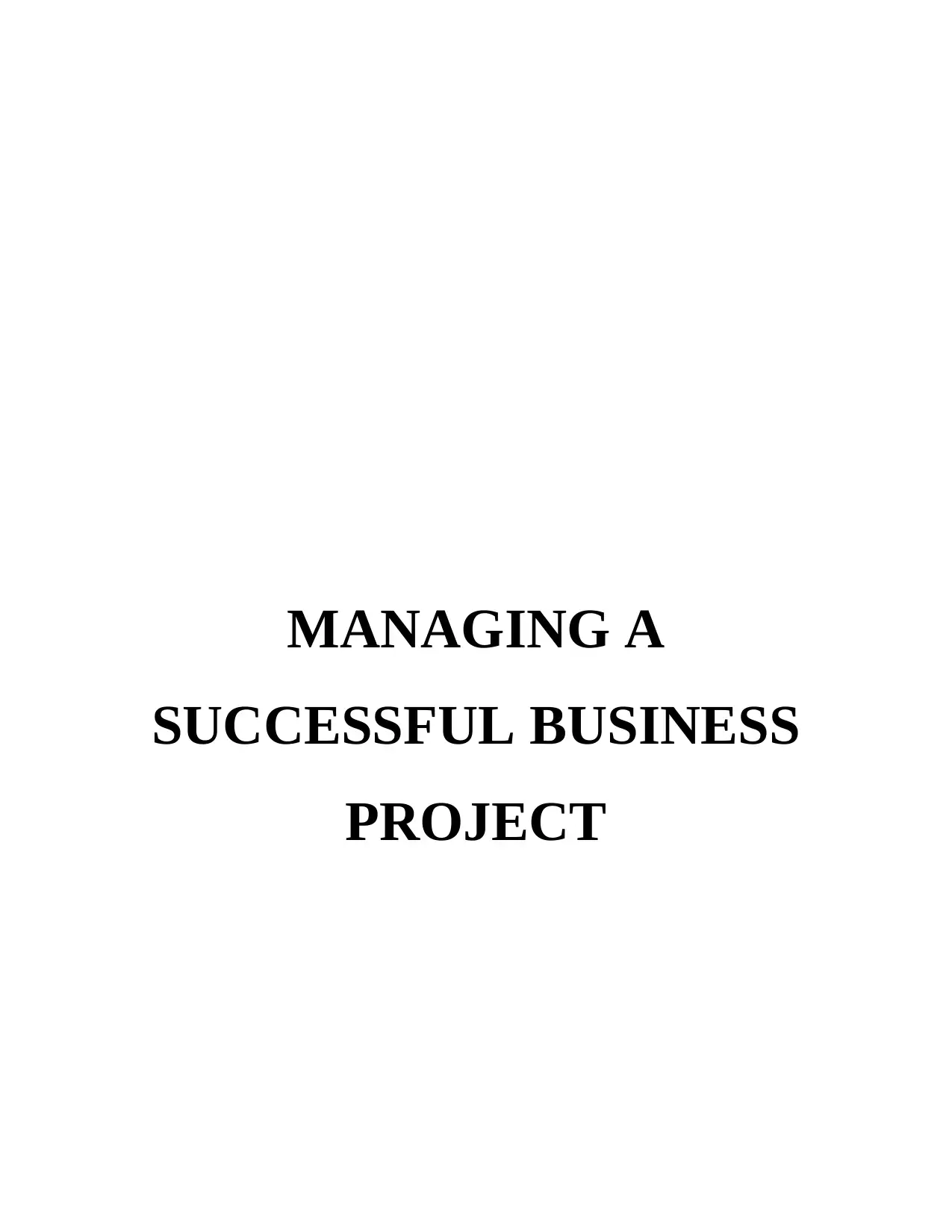
MANAGING A
SUCCESSFUL BUSINESS
PROJECT
SUCCESSFUL BUSINESS
PROJECT
Paraphrase This Document
Need a fresh take? Get an instant paraphrase of this document with our AI Paraphraser
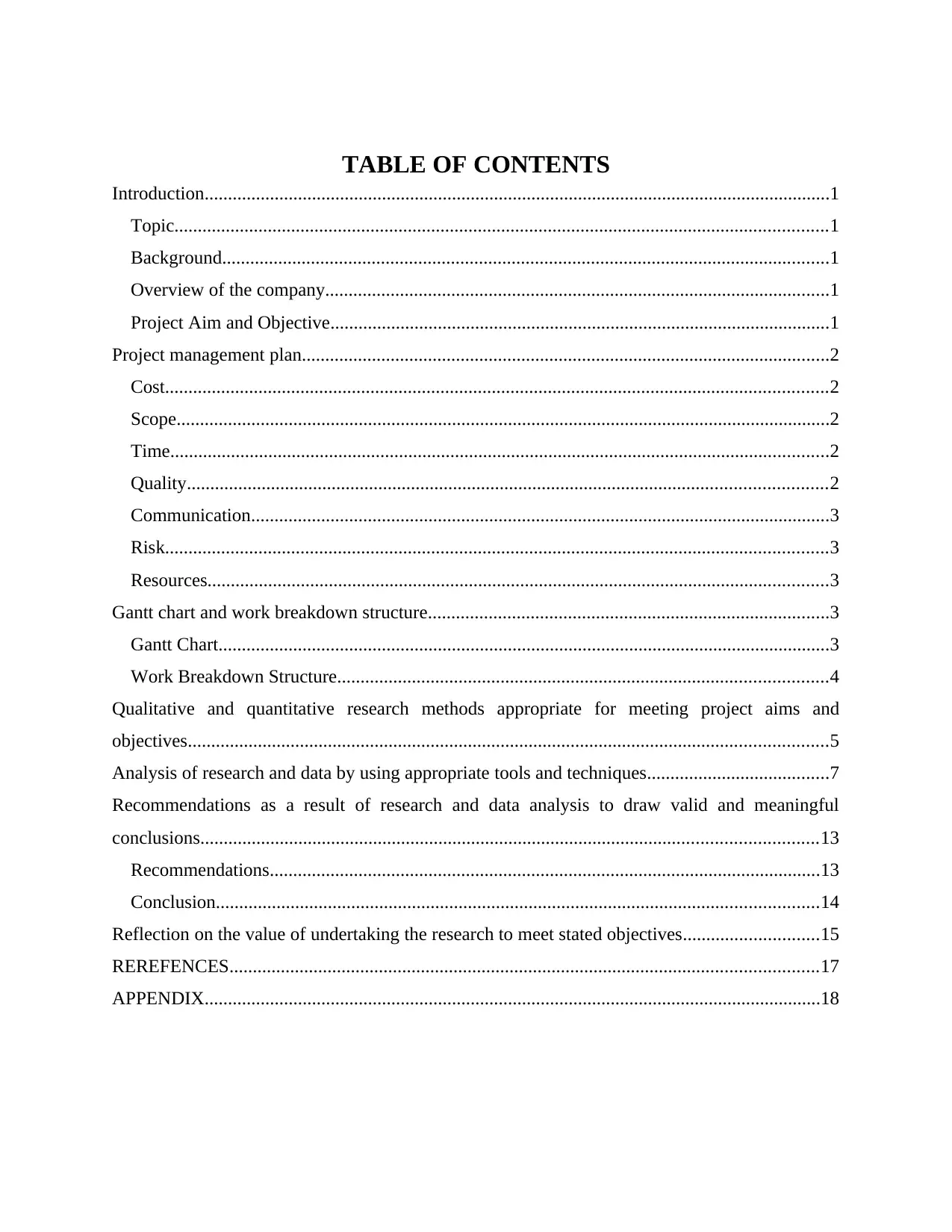
TABLE OF CONTENTS
Introduction......................................................................................................................................1
Topic............................................................................................................................................1
Background..................................................................................................................................1
Overview of the company............................................................................................................1
Project Aim and Objective...........................................................................................................1
Project management plan.................................................................................................................2
Cost..............................................................................................................................................2
Scope............................................................................................................................................2
Time.............................................................................................................................................2
Quality.........................................................................................................................................2
Communication............................................................................................................................3
Risk..............................................................................................................................................3
Resources.....................................................................................................................................3
Gantt chart and work breakdown structure......................................................................................3
Gantt Chart...................................................................................................................................3
Work Breakdown Structure.........................................................................................................4
Qualitative and quantitative research methods appropriate for meeting project aims and
objectives.........................................................................................................................................5
Analysis of research and data by using appropriate tools and techniques.......................................7
Recommendations as a result of research and data analysis to draw valid and meaningful
conclusions....................................................................................................................................13
Recommendations......................................................................................................................13
Conclusion.................................................................................................................................14
Reflection on the value of undertaking the research to meet stated objectives.............................15
REREFENCES..............................................................................................................................17
APPENDIX....................................................................................................................................18
Introduction......................................................................................................................................1
Topic............................................................................................................................................1
Background..................................................................................................................................1
Overview of the company............................................................................................................1
Project Aim and Objective...........................................................................................................1
Project management plan.................................................................................................................2
Cost..............................................................................................................................................2
Scope............................................................................................................................................2
Time.............................................................................................................................................2
Quality.........................................................................................................................................2
Communication............................................................................................................................3
Risk..............................................................................................................................................3
Resources.....................................................................................................................................3
Gantt chart and work breakdown structure......................................................................................3
Gantt Chart...................................................................................................................................3
Work Breakdown Structure.........................................................................................................4
Qualitative and quantitative research methods appropriate for meeting project aims and
objectives.........................................................................................................................................5
Analysis of research and data by using appropriate tools and techniques.......................................7
Recommendations as a result of research and data analysis to draw valid and meaningful
conclusions....................................................................................................................................13
Recommendations......................................................................................................................13
Conclusion.................................................................................................................................14
Reflection on the value of undertaking the research to meet stated objectives.............................15
REREFENCES..............................................................................................................................17
APPENDIX....................................................................................................................................18
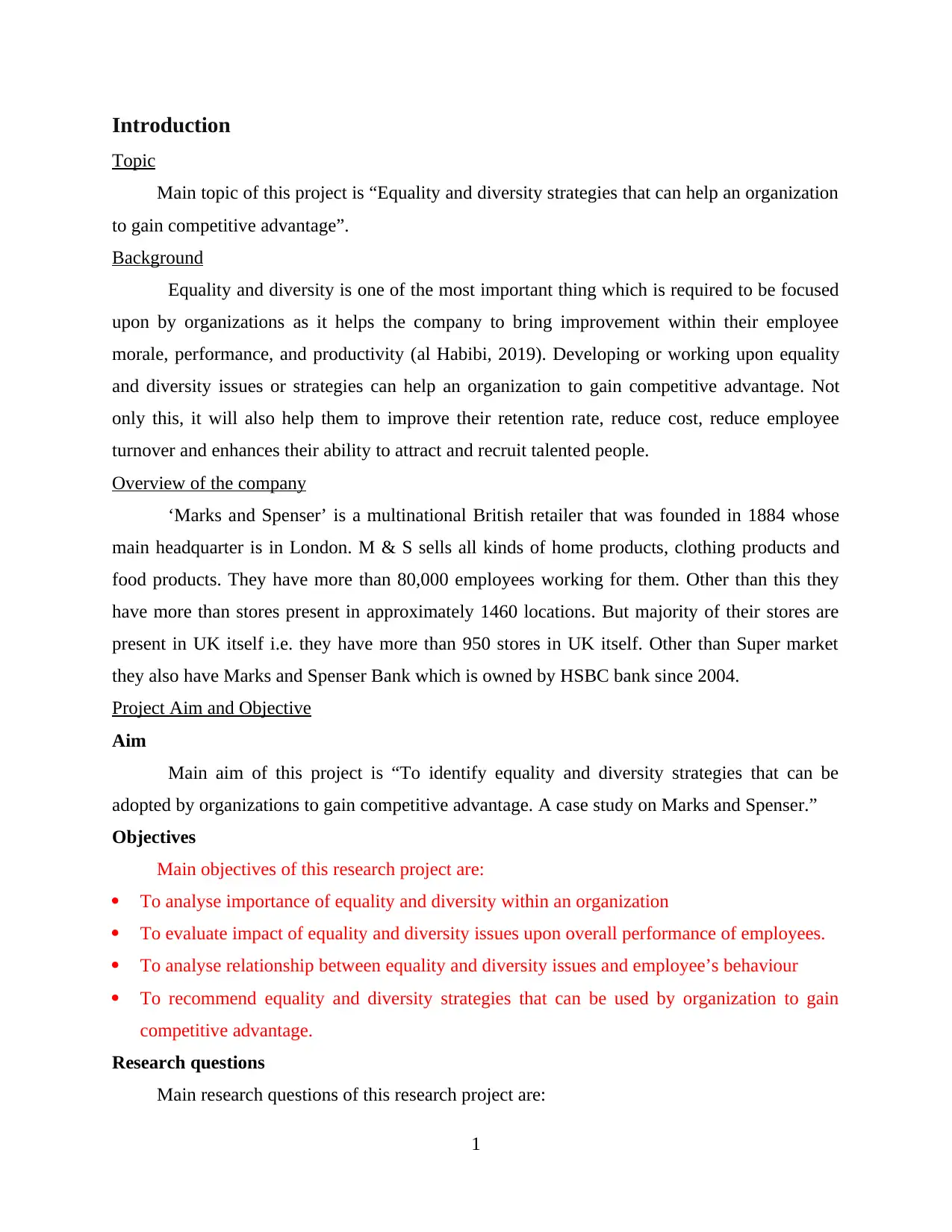
Introduction
Topic
Main topic of this project is “Equality and diversity strategies that can help an organization
to gain competitive advantage”.
Background
Equality and diversity is one of the most important thing which is required to be focused
upon by organizations as it helps the company to bring improvement within their employee
morale, performance, and productivity (al Habibi, 2019). Developing or working upon equality
and diversity issues or strategies can help an organization to gain competitive advantage. Not
only this, it will also help them to improve their retention rate, reduce cost, reduce employee
turnover and enhances their ability to attract and recruit talented people.
Overview of the company
‘Marks and Spenser’ is a multinational British retailer that was founded in 1884 whose
main headquarter is in London. M & S sells all kinds of home products, clothing products and
food products. They have more than 80,000 employees working for them. Other than this they
have more than stores present in approximately 1460 locations. But majority of their stores are
present in UK itself i.e. they have more than 950 stores in UK itself. Other than Super market
they also have Marks and Spenser Bank which is owned by HSBC bank since 2004.
Project Aim and Objective
Aim
Main aim of this project is “To identify equality and diversity strategies that can be
adopted by organizations to gain competitive advantage. A case study on Marks and Spenser.”
Objectives
Main objectives of this research project are:
To analyse importance of equality and diversity within an organization
To evaluate impact of equality and diversity issues upon overall performance of employees.
To analyse relationship between equality and diversity issues and employee’s behaviour
To recommend equality and diversity strategies that can be used by organization to gain
competitive advantage.
Research questions
Main research questions of this research project are:
1
Topic
Main topic of this project is “Equality and diversity strategies that can help an organization
to gain competitive advantage”.
Background
Equality and diversity is one of the most important thing which is required to be focused
upon by organizations as it helps the company to bring improvement within their employee
morale, performance, and productivity (al Habibi, 2019). Developing or working upon equality
and diversity issues or strategies can help an organization to gain competitive advantage. Not
only this, it will also help them to improve their retention rate, reduce cost, reduce employee
turnover and enhances their ability to attract and recruit talented people.
Overview of the company
‘Marks and Spenser’ is a multinational British retailer that was founded in 1884 whose
main headquarter is in London. M & S sells all kinds of home products, clothing products and
food products. They have more than 80,000 employees working for them. Other than this they
have more than stores present in approximately 1460 locations. But majority of their stores are
present in UK itself i.e. they have more than 950 stores in UK itself. Other than Super market
they also have Marks and Spenser Bank which is owned by HSBC bank since 2004.
Project Aim and Objective
Aim
Main aim of this project is “To identify equality and diversity strategies that can be
adopted by organizations to gain competitive advantage. A case study on Marks and Spenser.”
Objectives
Main objectives of this research project are:
To analyse importance of equality and diversity within an organization
To evaluate impact of equality and diversity issues upon overall performance of employees.
To analyse relationship between equality and diversity issues and employee’s behaviour
To recommend equality and diversity strategies that can be used by organization to gain
competitive advantage.
Research questions
Main research questions of this research project are:
1
⊘ This is a preview!⊘
Do you want full access?
Subscribe today to unlock all pages.

Trusted by 1+ million students worldwide
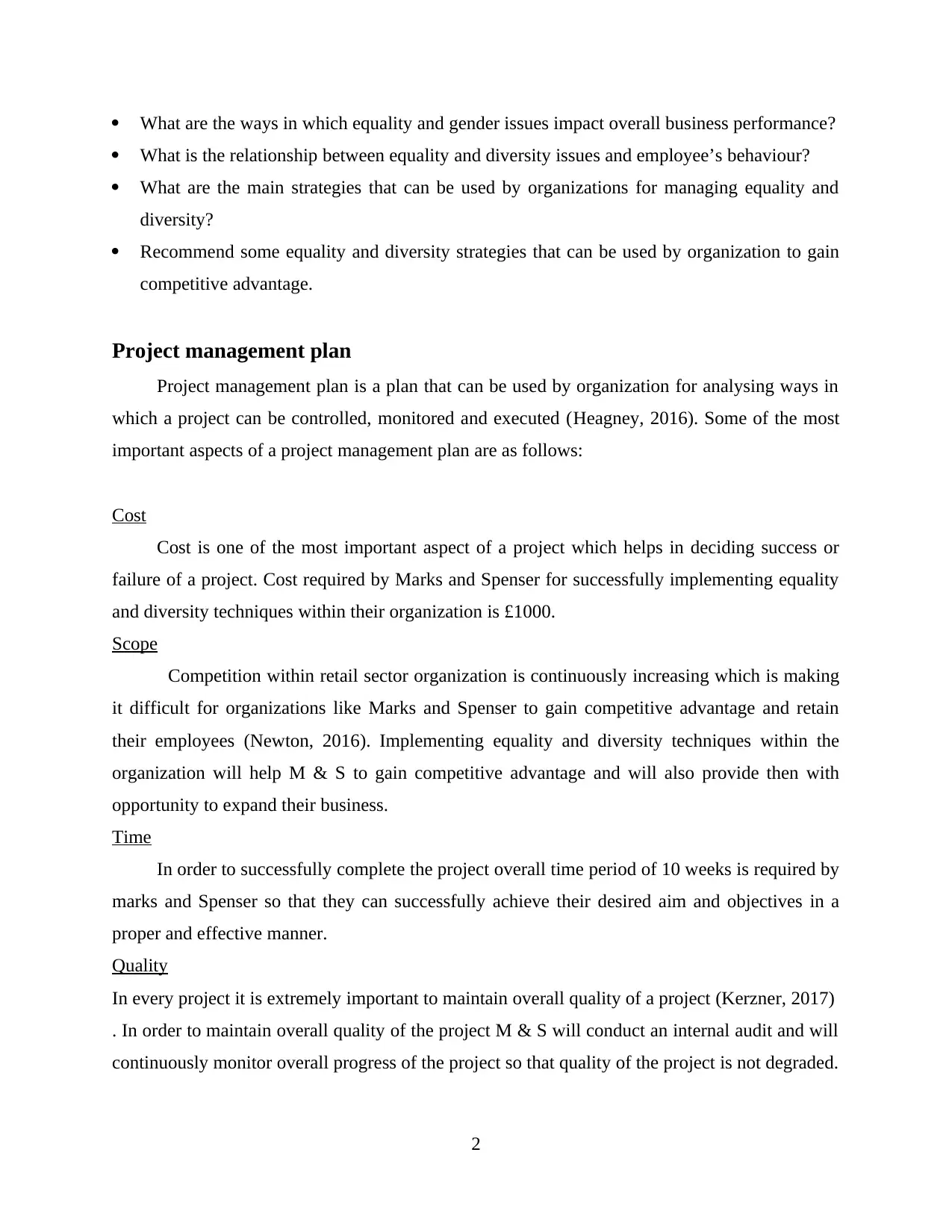
What are the ways in which equality and gender issues impact overall business performance?
What is the relationship between equality and diversity issues and employee’s behaviour?
What are the main strategies that can be used by organizations for managing equality and
diversity?
Recommend some equality and diversity strategies that can be used by organization to gain
competitive advantage.
Project management plan
Project management plan is a plan that can be used by organization for analysing ways in
which a project can be controlled, monitored and executed (Heagney, 2016). Some of the most
important aspects of a project management plan are as follows:
Cost
Cost is one of the most important aspect of a project which helps in deciding success or
failure of a project. Cost required by Marks and Spenser for successfully implementing equality
and diversity techniques within their organization is £1000.
Scope
Competition within retail sector organization is continuously increasing which is making
it difficult for organizations like Marks and Spenser to gain competitive advantage and retain
their employees (Newton, 2016). Implementing equality and diversity techniques within the
organization will help M & S to gain competitive advantage and will also provide then with
opportunity to expand their business.
Time
In order to successfully complete the project overall time period of 10 weeks is required by
marks and Spenser so that they can successfully achieve their desired aim and objectives in a
proper and effective manner.
Quality
In every project it is extremely important to maintain overall quality of a project (Kerzner, 2017)
. In order to maintain overall quality of the project M & S will conduct an internal audit and will
continuously monitor overall progress of the project so that quality of the project is not degraded.
2
What is the relationship between equality and diversity issues and employee’s behaviour?
What are the main strategies that can be used by organizations for managing equality and
diversity?
Recommend some equality and diversity strategies that can be used by organization to gain
competitive advantage.
Project management plan
Project management plan is a plan that can be used by organization for analysing ways in
which a project can be controlled, monitored and executed (Heagney, 2016). Some of the most
important aspects of a project management plan are as follows:
Cost
Cost is one of the most important aspect of a project which helps in deciding success or
failure of a project. Cost required by Marks and Spenser for successfully implementing equality
and diversity techniques within their organization is £1000.
Scope
Competition within retail sector organization is continuously increasing which is making
it difficult for organizations like Marks and Spenser to gain competitive advantage and retain
their employees (Newton, 2016). Implementing equality and diversity techniques within the
organization will help M & S to gain competitive advantage and will also provide then with
opportunity to expand their business.
Time
In order to successfully complete the project overall time period of 10 weeks is required by
marks and Spenser so that they can successfully achieve their desired aim and objectives in a
proper and effective manner.
Quality
In every project it is extremely important to maintain overall quality of a project (Kerzner, 2017)
. In order to maintain overall quality of the project M & S will conduct an internal audit and will
continuously monitor overall progress of the project so that quality of the project is not degraded.
2
Paraphrase This Document
Need a fresh take? Get an instant paraphrase of this document with our AI Paraphraser
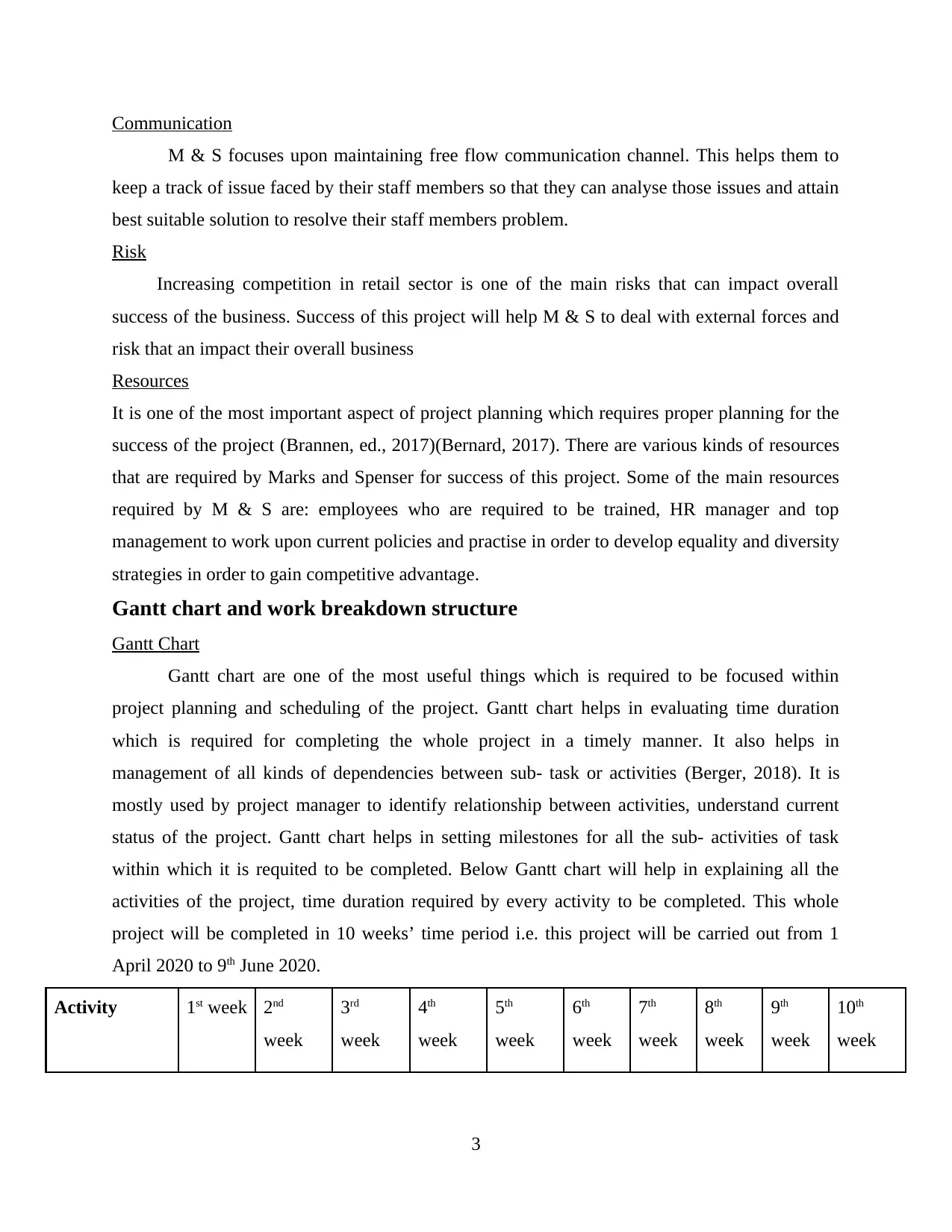
Communication
M & S focuses upon maintaining free flow communication channel. This helps them to
keep a track of issue faced by their staff members so that they can analyse those issues and attain
best suitable solution to resolve their staff members problem.
Risk
Increasing competition in retail sector is one of the main risks that can impact overall
success of the business. Success of this project will help M & S to deal with external forces and
risk that an impact their overall business
Resources
It is one of the most important aspect of project planning which requires proper planning for the
success of the project (Brannen, ed., 2017)(Bernard, 2017). There are various kinds of resources
that are required by Marks and Spenser for success of this project. Some of the main resources
required by M & S are: employees who are required to be trained, HR manager and top
management to work upon current policies and practise in order to develop equality and diversity
strategies in order to gain competitive advantage.
Gantt chart and work breakdown structure
Gantt Chart
Gantt chart are one of the most useful things which is required to be focused within
project planning and scheduling of the project. Gantt chart helps in evaluating time duration
which is required for completing the whole project in a timely manner. It also helps in
management of all kinds of dependencies between sub- task or activities (Berger, 2018). It is
mostly used by project manager to identify relationship between activities, understand current
status of the project. Gantt chart helps in setting milestones for all the sub- activities of task
within which it is requited to be completed. Below Gantt chart will help in explaining all the
activities of the project, time duration required by every activity to be completed. This whole
project will be completed in 10 weeks’ time period i.e. this project will be carried out from 1
April 2020 to 9th June 2020.
Activity 1st week 2nd
week
3rd
week
4th
week
5th
week
6th
week
7th
week
8th
week
9th
week
10th
week
3
M & S focuses upon maintaining free flow communication channel. This helps them to
keep a track of issue faced by their staff members so that they can analyse those issues and attain
best suitable solution to resolve their staff members problem.
Risk
Increasing competition in retail sector is one of the main risks that can impact overall
success of the business. Success of this project will help M & S to deal with external forces and
risk that an impact their overall business
Resources
It is one of the most important aspect of project planning which requires proper planning for the
success of the project (Brannen, ed., 2017)(Bernard, 2017). There are various kinds of resources
that are required by Marks and Spenser for success of this project. Some of the main resources
required by M & S are: employees who are required to be trained, HR manager and top
management to work upon current policies and practise in order to develop equality and diversity
strategies in order to gain competitive advantage.
Gantt chart and work breakdown structure
Gantt Chart
Gantt chart are one of the most useful things which is required to be focused within
project planning and scheduling of the project. Gantt chart helps in evaluating time duration
which is required for completing the whole project in a timely manner. It also helps in
management of all kinds of dependencies between sub- task or activities (Berger, 2018). It is
mostly used by project manager to identify relationship between activities, understand current
status of the project. Gantt chart helps in setting milestones for all the sub- activities of task
within which it is requited to be completed. Below Gantt chart will help in explaining all the
activities of the project, time duration required by every activity to be completed. This whole
project will be completed in 10 weeks’ time period i.e. this project will be carried out from 1
April 2020 to 9th June 2020.
Activity 1st week 2nd
week
3rd
week
4th
week
5th
week
6th
week
7th
week
8th
week
9th
week
10th
week
3
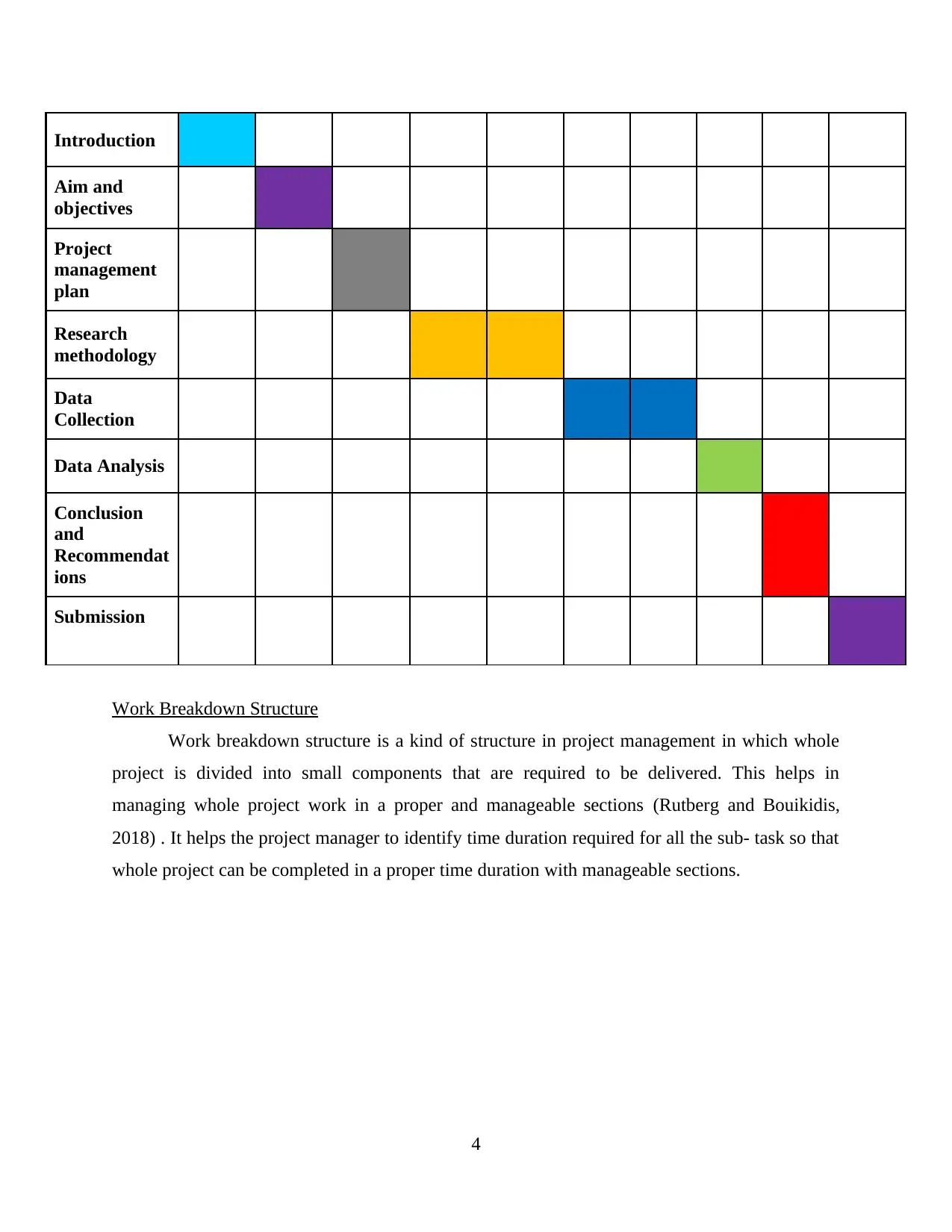
Introduction
Aim and
objectives
Project
management
plan
Research
methodology
Data
Collection
Data Analysis
Conclusion
and
Recommendat
ions
Submission
Work Breakdown Structure
Work breakdown structure is a kind of structure in project management in which whole
project is divided into small components that are required to be delivered. This helps in
managing whole project work in a proper and manageable sections (Rutberg and Bouikidis,
2018) . It helps the project manager to identify time duration required for all the sub- task so that
whole project can be completed in a proper time duration with manageable sections.
4
Aim and
objectives
Project
management
plan
Research
methodology
Data
Collection
Data Analysis
Conclusion
and
Recommendat
ions
Submission
Work Breakdown Structure
Work breakdown structure is a kind of structure in project management in which whole
project is divided into small components that are required to be delivered. This helps in
managing whole project work in a proper and manageable sections (Rutberg and Bouikidis,
2018) . It helps the project manager to identify time duration required for all the sub- task so that
whole project can be completed in a proper time duration with manageable sections.
4
⊘ This is a preview!⊘
Do you want full access?
Subscribe today to unlock all pages.

Trusted by 1+ million students worldwide
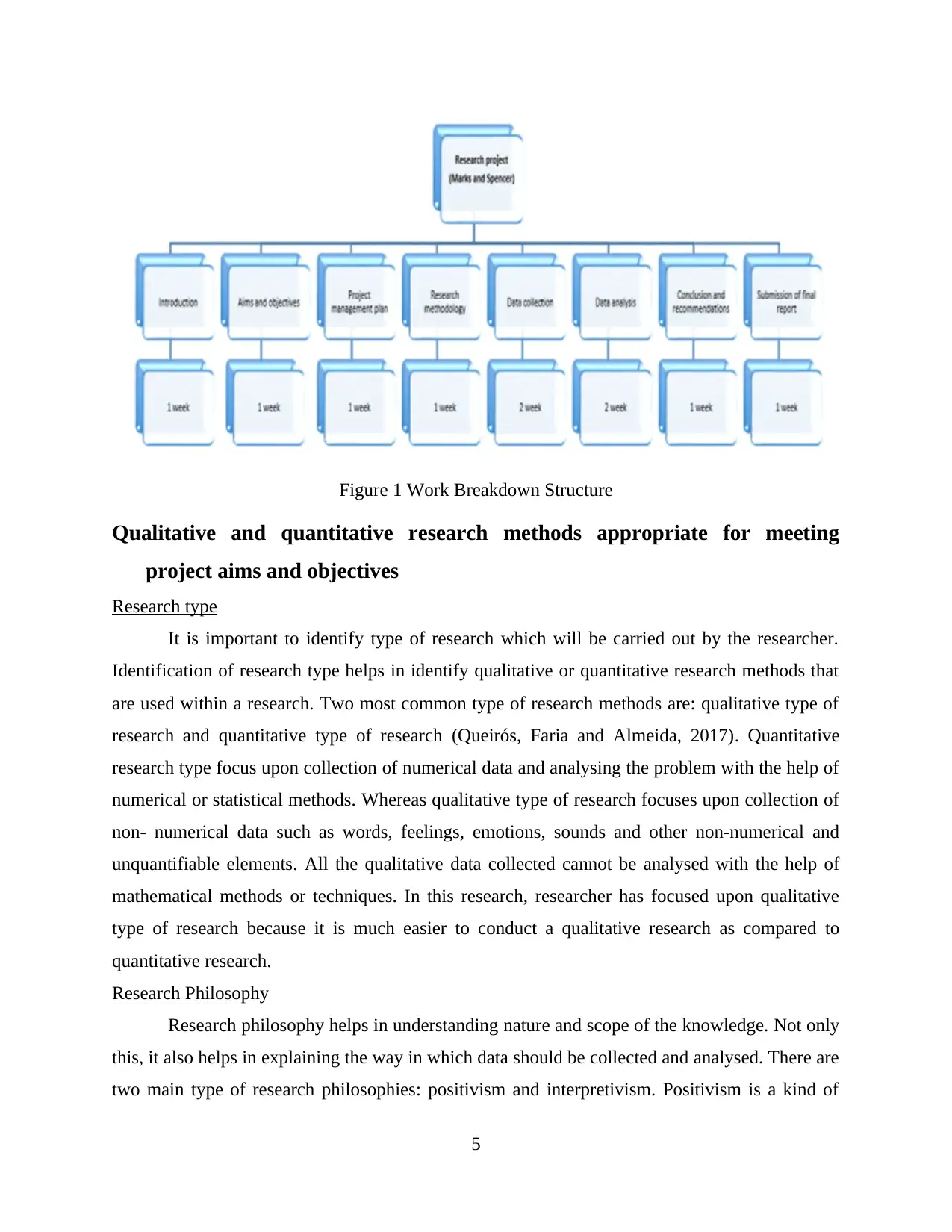
Figure 1 Work Breakdown Structure
Qualitative and quantitative research methods appropriate for meeting
project aims and objectives
Research type
It is important to identify type of research which will be carried out by the researcher.
Identification of research type helps in identify qualitative or quantitative research methods that
are used within a research. Two most common type of research methods are: qualitative type of
research and quantitative type of research (Queirós, Faria and Almeida, 2017). Quantitative
research type focus upon collection of numerical data and analysing the problem with the help of
numerical or statistical methods. Whereas qualitative type of research focuses upon collection of
non- numerical data such as words, feelings, emotions, sounds and other non-numerical and
unquantifiable elements. All the qualitative data collected cannot be analysed with the help of
mathematical methods or techniques. In this research, researcher has focused upon qualitative
type of research because it is much easier to conduct a qualitative research as compared to
quantitative research.
Research Philosophy
Research philosophy helps in understanding nature and scope of the knowledge. Not only
this, it also helps in explaining the way in which data should be collected and analysed. There are
two main type of research philosophies: positivism and interpretivism. Positivism is a kind of
5
Qualitative and quantitative research methods appropriate for meeting
project aims and objectives
Research type
It is important to identify type of research which will be carried out by the researcher.
Identification of research type helps in identify qualitative or quantitative research methods that
are used within a research. Two most common type of research methods are: qualitative type of
research and quantitative type of research (Queirós, Faria and Almeida, 2017). Quantitative
research type focus upon collection of numerical data and analysing the problem with the help of
numerical or statistical methods. Whereas qualitative type of research focuses upon collection of
non- numerical data such as words, feelings, emotions, sounds and other non-numerical and
unquantifiable elements. All the qualitative data collected cannot be analysed with the help of
mathematical methods or techniques. In this research, researcher has focused upon qualitative
type of research because it is much easier to conduct a qualitative research as compared to
quantitative research.
Research Philosophy
Research philosophy helps in understanding nature and scope of the knowledge. Not only
this, it also helps in explaining the way in which data should be collected and analysed. There are
two main type of research philosophies: positivism and interpretivism. Positivism is a kind of
5
Paraphrase This Document
Need a fresh take? Get an instant paraphrase of this document with our AI Paraphraser
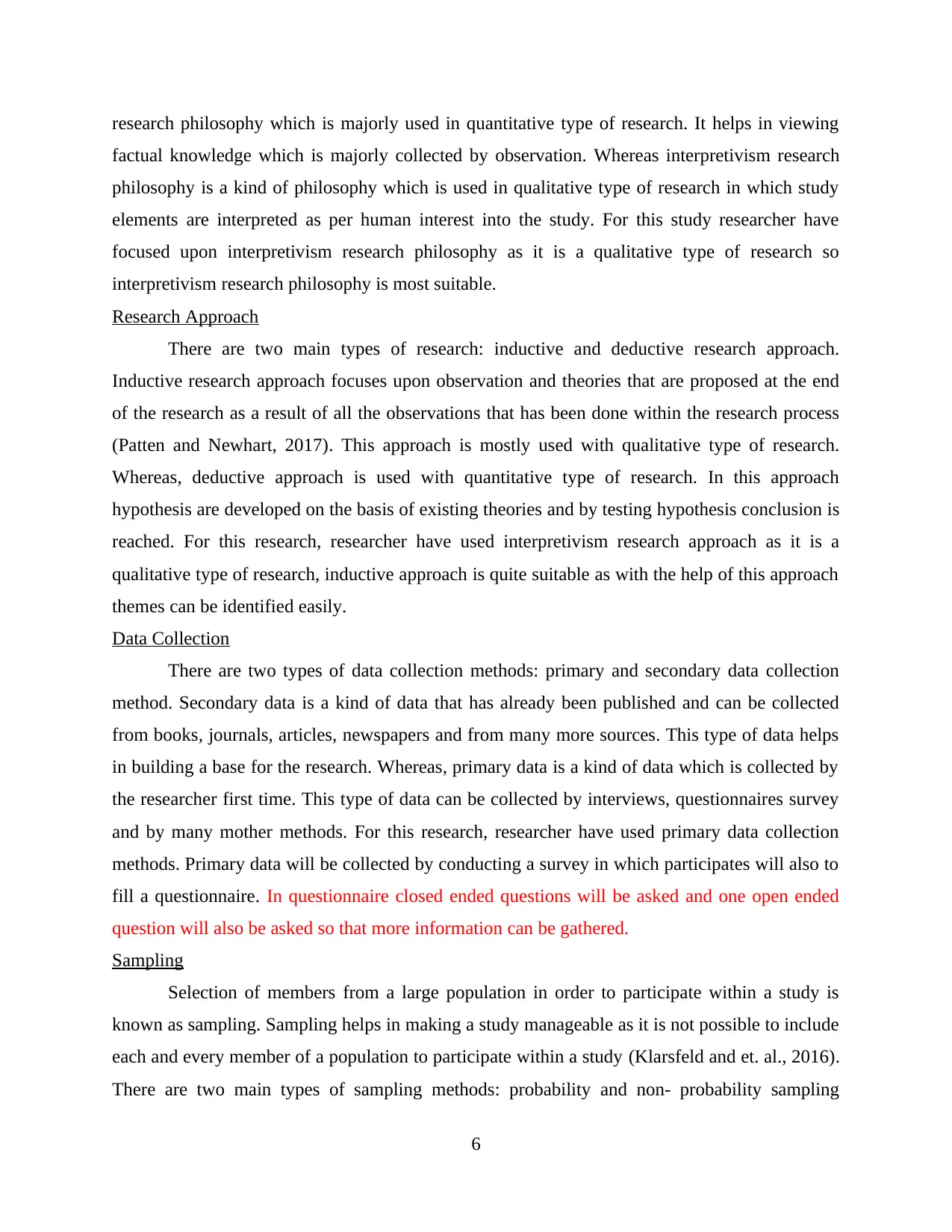
research philosophy which is majorly used in quantitative type of research. It helps in viewing
factual knowledge which is majorly collected by observation. Whereas interpretivism research
philosophy is a kind of philosophy which is used in qualitative type of research in which study
elements are interpreted as per human interest into the study. For this study researcher have
focused upon interpretivism research philosophy as it is a qualitative type of research so
interpretivism research philosophy is most suitable.
Research Approach
There are two main types of research: inductive and deductive research approach.
Inductive research approach focuses upon observation and theories that are proposed at the end
of the research as a result of all the observations that has been done within the research process
(Patten and Newhart, 2017). This approach is mostly used with qualitative type of research.
Whereas, deductive approach is used with quantitative type of research. In this approach
hypothesis are developed on the basis of existing theories and by testing hypothesis conclusion is
reached. For this research, researcher have used interpretivism research approach as it is a
qualitative type of research, inductive approach is quite suitable as with the help of this approach
themes can be identified easily.
Data Collection
There are two types of data collection methods: primary and secondary data collection
method. Secondary data is a kind of data that has already been published and can be collected
from books, journals, articles, newspapers and from many more sources. This type of data helps
in building a base for the research. Whereas, primary data is a kind of data which is collected by
the researcher first time. This type of data can be collected by interviews, questionnaires survey
and by many mother methods. For this research, researcher have used primary data collection
methods. Primary data will be collected by conducting a survey in which participates will also to
fill a questionnaire. In questionnaire closed ended questions will be asked and one open ended
question will also be asked so that more information can be gathered.
Sampling
Selection of members from a large population in order to participate within a study is
known as sampling. Sampling helps in making a study manageable as it is not possible to include
each and every member of a population to participate within a study (Klarsfeld and et. al., 2016).
There are two main types of sampling methods: probability and non- probability sampling
6
factual knowledge which is majorly collected by observation. Whereas interpretivism research
philosophy is a kind of philosophy which is used in qualitative type of research in which study
elements are interpreted as per human interest into the study. For this study researcher have
focused upon interpretivism research philosophy as it is a qualitative type of research so
interpretivism research philosophy is most suitable.
Research Approach
There are two main types of research: inductive and deductive research approach.
Inductive research approach focuses upon observation and theories that are proposed at the end
of the research as a result of all the observations that has been done within the research process
(Patten and Newhart, 2017). This approach is mostly used with qualitative type of research.
Whereas, deductive approach is used with quantitative type of research. In this approach
hypothesis are developed on the basis of existing theories and by testing hypothesis conclusion is
reached. For this research, researcher have used interpretivism research approach as it is a
qualitative type of research, inductive approach is quite suitable as with the help of this approach
themes can be identified easily.
Data Collection
There are two types of data collection methods: primary and secondary data collection
method. Secondary data is a kind of data that has already been published and can be collected
from books, journals, articles, newspapers and from many more sources. This type of data helps
in building a base for the research. Whereas, primary data is a kind of data which is collected by
the researcher first time. This type of data can be collected by interviews, questionnaires survey
and by many mother methods. For this research, researcher have used primary data collection
methods. Primary data will be collected by conducting a survey in which participates will also to
fill a questionnaire. In questionnaire closed ended questions will be asked and one open ended
question will also be asked so that more information can be gathered.
Sampling
Selection of members from a large population in order to participate within a study is
known as sampling. Sampling helps in making a study manageable as it is not possible to include
each and every member of a population to participate within a study (Klarsfeld and et. al., 2016).
There are two main types of sampling methods: probability and non- probability sampling
6
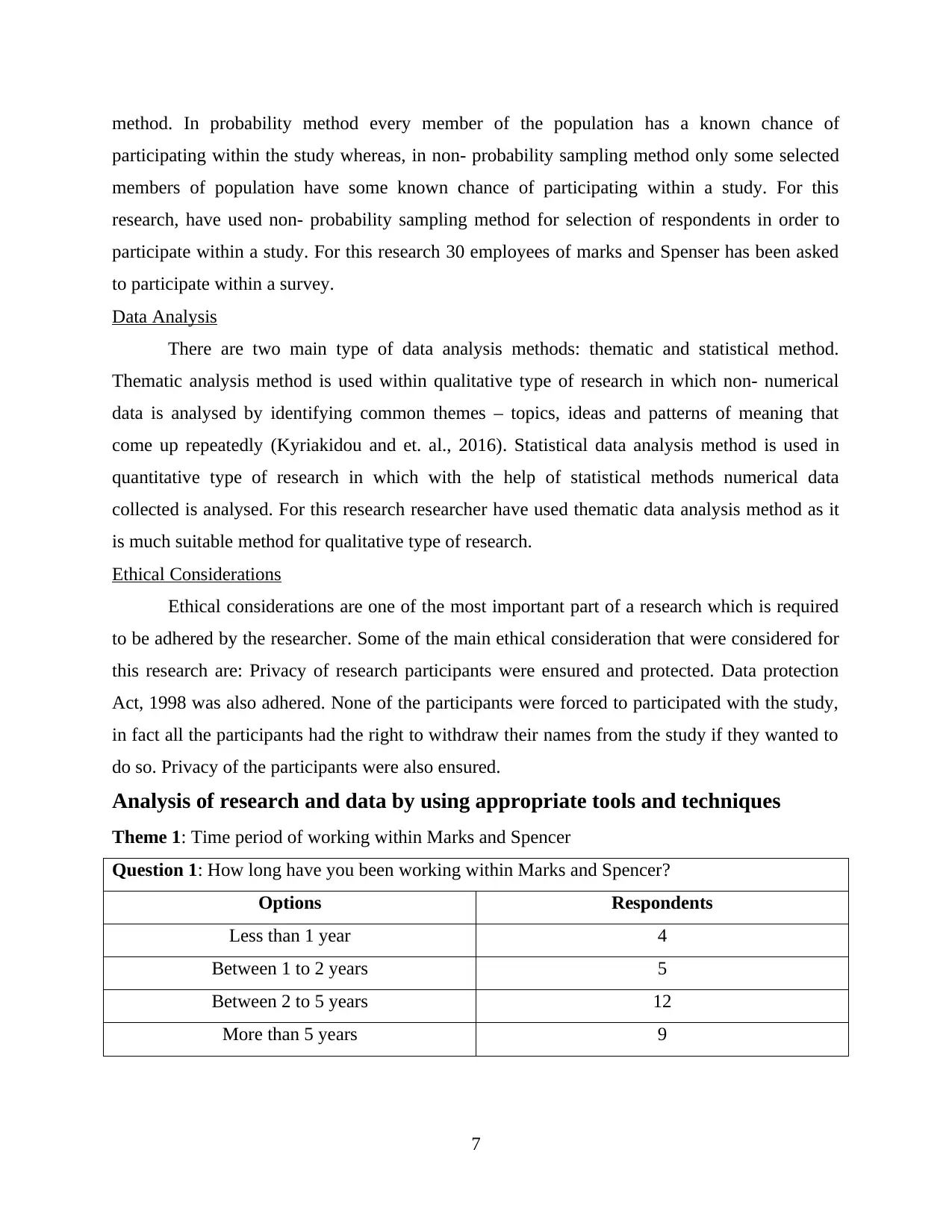
method. In probability method every member of the population has a known chance of
participating within the study whereas, in non- probability sampling method only some selected
members of population have some known chance of participating within a study. For this
research, have used non- probability sampling method for selection of respondents in order to
participate within a study. For this research 30 employees of marks and Spenser has been asked
to participate within a survey.
Data Analysis
There are two main type of data analysis methods: thematic and statistical method.
Thematic analysis method is used within qualitative type of research in which non- numerical
data is analysed by identifying common themes – topics, ideas and patterns of meaning that
come up repeatedly (Kyriakidou and et. al., 2016). Statistical data analysis method is used in
quantitative type of research in which with the help of statistical methods numerical data
collected is analysed. For this research researcher have used thematic data analysis method as it
is much suitable method for qualitative type of research.
Ethical Considerations
Ethical considerations are one of the most important part of a research which is required
to be adhered by the researcher. Some of the main ethical consideration that were considered for
this research are: Privacy of research participants were ensured and protected. Data protection
Act, 1998 was also adhered. None of the participants were forced to participated with the study,
in fact all the participants had the right to withdraw their names from the study if they wanted to
do so. Privacy of the participants were also ensured.
Analysis of research and data by using appropriate tools and techniques
Theme 1: Time period of working within Marks and Spencer
Question 1: How long have you been working within Marks and Spencer?
Options Respondents
Less than 1 year 4
Between 1 to 2 years 5
Between 2 to 5 years 12
More than 5 years 9
7
participating within the study whereas, in non- probability sampling method only some selected
members of population have some known chance of participating within a study. For this
research, have used non- probability sampling method for selection of respondents in order to
participate within a study. For this research 30 employees of marks and Spenser has been asked
to participate within a survey.
Data Analysis
There are two main type of data analysis methods: thematic and statistical method.
Thematic analysis method is used within qualitative type of research in which non- numerical
data is analysed by identifying common themes – topics, ideas and patterns of meaning that
come up repeatedly (Kyriakidou and et. al., 2016). Statistical data analysis method is used in
quantitative type of research in which with the help of statistical methods numerical data
collected is analysed. For this research researcher have used thematic data analysis method as it
is much suitable method for qualitative type of research.
Ethical Considerations
Ethical considerations are one of the most important part of a research which is required
to be adhered by the researcher. Some of the main ethical consideration that were considered for
this research are: Privacy of research participants were ensured and protected. Data protection
Act, 1998 was also adhered. None of the participants were forced to participated with the study,
in fact all the participants had the right to withdraw their names from the study if they wanted to
do so. Privacy of the participants were also ensured.
Analysis of research and data by using appropriate tools and techniques
Theme 1: Time period of working within Marks and Spencer
Question 1: How long have you been working within Marks and Spencer?
Options Respondents
Less than 1 year 4
Between 1 to 2 years 5
Between 2 to 5 years 12
More than 5 years 9
7
⊘ This is a preview!⊘
Do you want full access?
Subscribe today to unlock all pages.

Trusted by 1+ million students worldwide
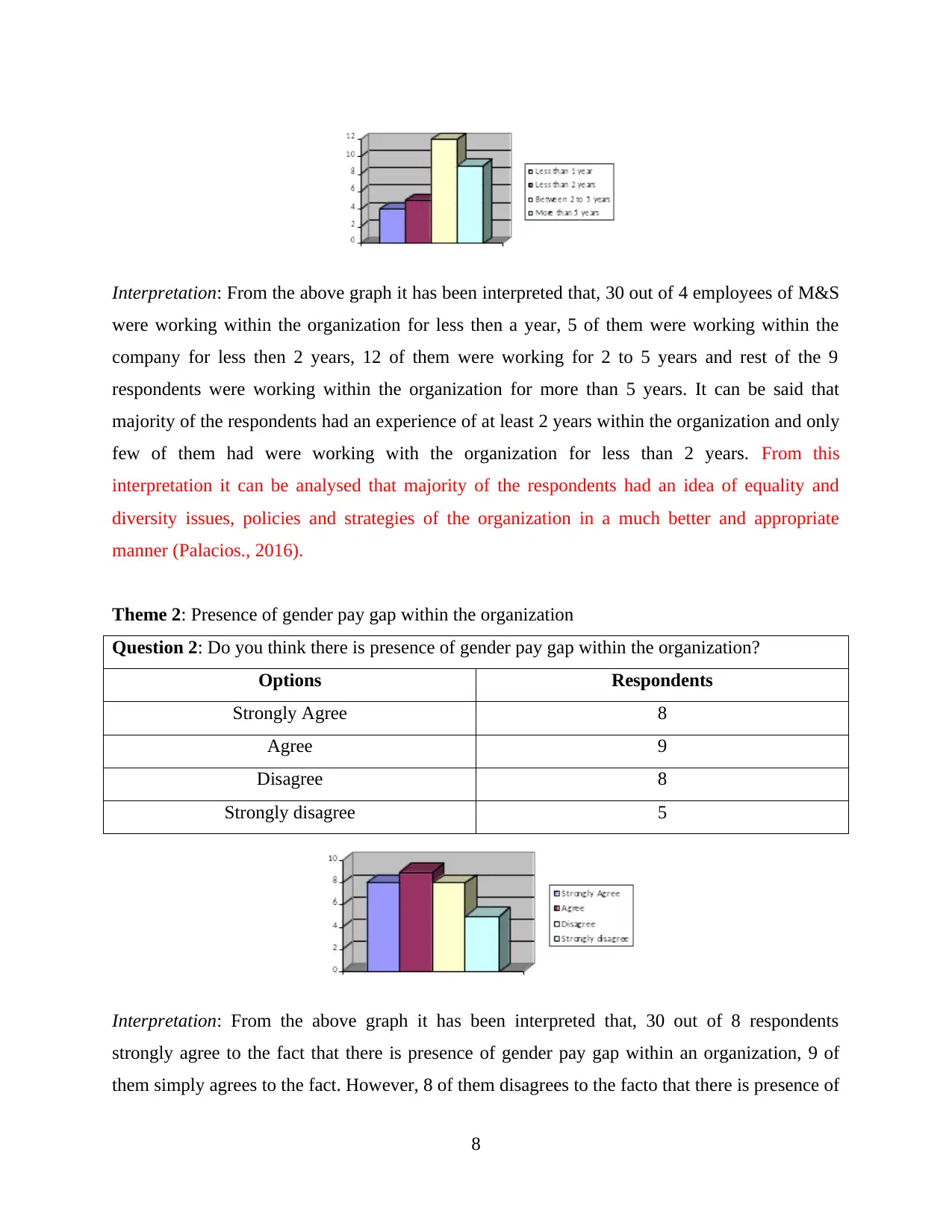
Interpretation: From the above graph it has been interpreted that, 30 out of 4 employees of M&S
were working within the organization for less then a year, 5 of them were working within the
company for less then 2 years, 12 of them were working for 2 to 5 years and rest of the 9
respondents were working within the organization for more than 5 years. It can be said that
majority of the respondents had an experience of at least 2 years within the organization and only
few of them had were working with the organization for less than 2 years. From this
interpretation it can be analysed that majority of the respondents had an idea of equality and
diversity issues, policies and strategies of the organization in a much better and appropriate
manner (Palacios., 2016).
Theme 2: Presence of gender pay gap within the organization
Question 2: Do you think there is presence of gender pay gap within the organization?
Options Respondents
Strongly Agree 8
Agree 9
Disagree 8
Strongly disagree 5
Interpretation: From the above graph it has been interpreted that, 30 out of 8 respondents
strongly agree to the fact that there is presence of gender pay gap within an organization, 9 of
them simply agrees to the fact. However, 8 of them disagrees to the facto that there is presence of
8
were working within the organization for less then a year, 5 of them were working within the
company for less then 2 years, 12 of them were working for 2 to 5 years and rest of the 9
respondents were working within the organization for more than 5 years. It can be said that
majority of the respondents had an experience of at least 2 years within the organization and only
few of them had were working with the organization for less than 2 years. From this
interpretation it can be analysed that majority of the respondents had an idea of equality and
diversity issues, policies and strategies of the organization in a much better and appropriate
manner (Palacios., 2016).
Theme 2: Presence of gender pay gap within the organization
Question 2: Do you think there is presence of gender pay gap within the organization?
Options Respondents
Strongly Agree 8
Agree 9
Disagree 8
Strongly disagree 5
Interpretation: From the above graph it has been interpreted that, 30 out of 8 respondents
strongly agree to the fact that there is presence of gender pay gap within an organization, 9 of
them simply agrees to the fact. However, 8 of them disagrees to the facto that there is presence of
8
Paraphrase This Document
Need a fresh take? Get an instant paraphrase of this document with our AI Paraphraser
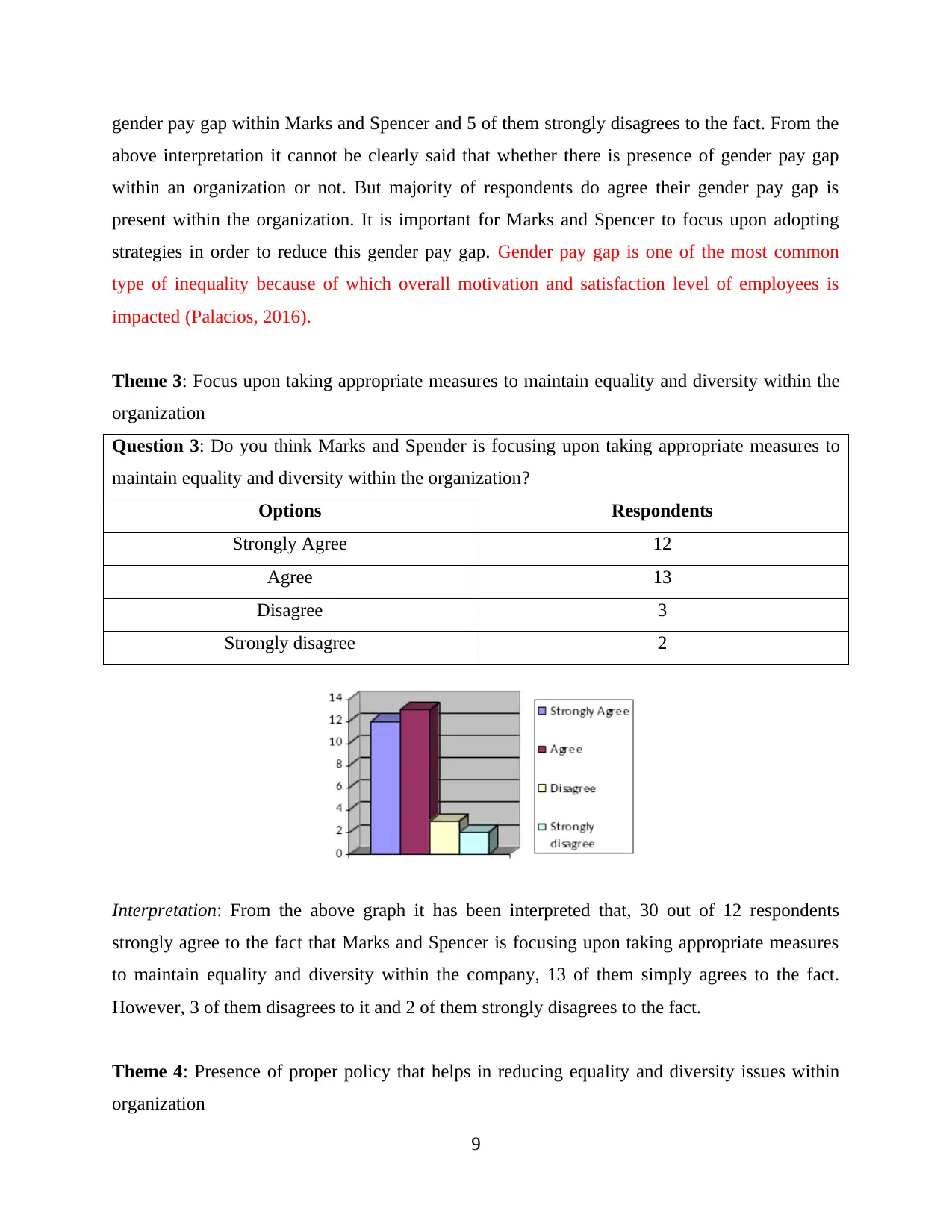
gender pay gap within Marks and Spencer and 5 of them strongly disagrees to the fact. From the
above interpretation it cannot be clearly said that whether there is presence of gender pay gap
within an organization or not. But majority of respondents do agree their gender pay gap is
present within the organization. It is important for Marks and Spencer to focus upon adopting
strategies in order to reduce this gender pay gap. Gender pay gap is one of the most common
type of inequality because of which overall motivation and satisfaction level of employees is
impacted (Palacios, 2016).
Theme 3: Focus upon taking appropriate measures to maintain equality and diversity within the
organization
Question 3: Do you think Marks and Spender is focusing upon taking appropriate measures to
maintain equality and diversity within the organization?
Options Respondents
Strongly Agree 12
Agree 13
Disagree 3
Strongly disagree 2
Interpretation: From the above graph it has been interpreted that, 30 out of 12 respondents
strongly agree to the fact that Marks and Spencer is focusing upon taking appropriate measures
to maintain equality and diversity within the company, 13 of them simply agrees to the fact.
However, 3 of them disagrees to it and 2 of them strongly disagrees to the fact.
Theme 4: Presence of proper policy that helps in reducing equality and diversity issues within
organization
9
above interpretation it cannot be clearly said that whether there is presence of gender pay gap
within an organization or not. But majority of respondents do agree their gender pay gap is
present within the organization. It is important for Marks and Spencer to focus upon adopting
strategies in order to reduce this gender pay gap. Gender pay gap is one of the most common
type of inequality because of which overall motivation and satisfaction level of employees is
impacted (Palacios, 2016).
Theme 3: Focus upon taking appropriate measures to maintain equality and diversity within the
organization
Question 3: Do you think Marks and Spender is focusing upon taking appropriate measures to
maintain equality and diversity within the organization?
Options Respondents
Strongly Agree 12
Agree 13
Disagree 3
Strongly disagree 2
Interpretation: From the above graph it has been interpreted that, 30 out of 12 respondents
strongly agree to the fact that Marks and Spencer is focusing upon taking appropriate measures
to maintain equality and diversity within the company, 13 of them simply agrees to the fact.
However, 3 of them disagrees to it and 2 of them strongly disagrees to the fact.
Theme 4: Presence of proper policy that helps in reducing equality and diversity issues within
organization
9
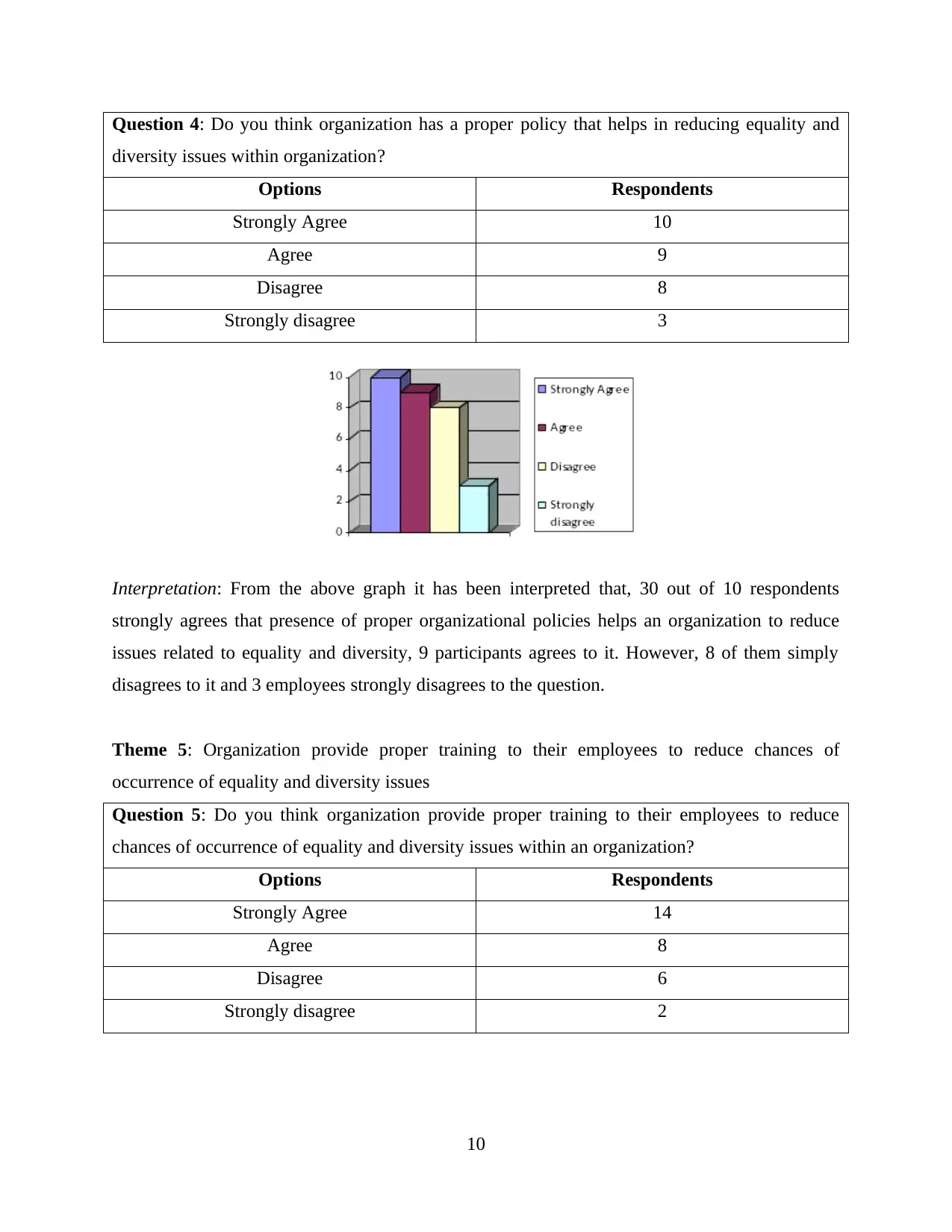
Question 4: Do you think organization has a proper policy that helps in reducing equality and
diversity issues within organization?
Options Respondents
Strongly Agree 10
Agree 9
Disagree 8
Strongly disagree 3
Interpretation: From the above graph it has been interpreted that, 30 out of 10 respondents
strongly agrees that presence of proper organizational policies helps an organization to reduce
issues related to equality and diversity, 9 participants agrees to it. However, 8 of them simply
disagrees to it and 3 employees strongly disagrees to the question.
Theme 5: Organization provide proper training to their employees to reduce chances of
occurrence of equality and diversity issues
Question 5: Do you think organization provide proper training to their employees to reduce
chances of occurrence of equality and diversity issues within an organization?
Options Respondents
Strongly Agree 14
Agree 8
Disagree 6
Strongly disagree 2
10
diversity issues within organization?
Options Respondents
Strongly Agree 10
Agree 9
Disagree 8
Strongly disagree 3
Interpretation: From the above graph it has been interpreted that, 30 out of 10 respondents
strongly agrees that presence of proper organizational policies helps an organization to reduce
issues related to equality and diversity, 9 participants agrees to it. However, 8 of them simply
disagrees to it and 3 employees strongly disagrees to the question.
Theme 5: Organization provide proper training to their employees to reduce chances of
occurrence of equality and diversity issues
Question 5: Do you think organization provide proper training to their employees to reduce
chances of occurrence of equality and diversity issues within an organization?
Options Respondents
Strongly Agree 14
Agree 8
Disagree 6
Strongly disagree 2
10
⊘ This is a preview!⊘
Do you want full access?
Subscribe today to unlock all pages.

Trusted by 1+ million students worldwide
1 out of 21
Related Documents
Your All-in-One AI-Powered Toolkit for Academic Success.
+13062052269
info@desklib.com
Available 24*7 on WhatsApp / Email
![[object Object]](/_next/static/media/star-bottom.7253800d.svg)
Unlock your academic potential
Copyright © 2020–2025 A2Z Services. All Rights Reserved. Developed and managed by ZUCOL.





